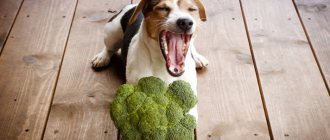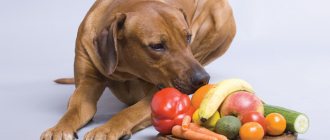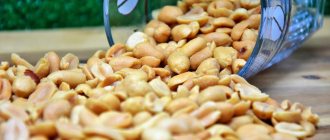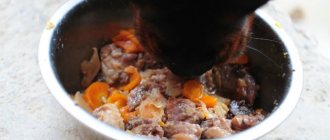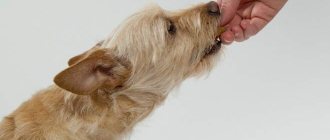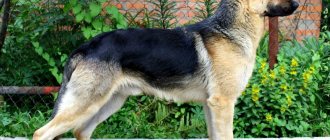Sweets are prohibited for dogs, but still some owners occasionally give their pets a piece of sugar, candy, chocolate or other “human” sweets despite the prohibitions.
If you really want to pamper your pet with something sweet, it is better to give him a small amount of honey rather than candy and other sweets.
Bee honey is a sweet and healthy product. In small quantities it is easily absorbed. Bee honey can be given to dogs, because it is, in fact, a natural food supplement and contains a lot of vitamins and minerals.
The natural product contains enzymes that promote better digestion of food, provides energy, therefore is useful for active dogs, and has a positive effect on the condition of the animal’s coat.
It is especially recommended for puppies, primarily those who grow up without a mother. For puppies, it is dissolved in milk. It is recommended to include honey in the diet of elderly, sick or weakened dogs to strengthen the immune system, but only if they are not allergic to this product.
The benefits of honey for dogs
There is no consensus among dog breeders about whether dogs can have honey. Some breeders feed puppies with honey diluted in water or milk. Many people regularly feed bee products to their dogs. It all depends on the individual characteristics of each animal.
Honey is a natural product, rich in beneficial substances that are easily absorbed not only by humans, but also by the animal body. It contains a huge amount of nutrients that can increase resistance to disease. Among them:
- glucose;
- sucrose;
- a number of organic acids;
- useful mineral compounds;
- a number of vitamins and fructose;
- phytoncides;
- enzymes.
Honey is an excellent immunomodulator created by nature. In addition to its tonic properties, it has the ability to have a positive effect on the dog’s nervous system. A spoonful of honey twice a week will help the bitch bear and give birth to healthy offspring.
A small puppy, especially with artificial feeding, which especially needs nutrients and good immunity, will develop faster if it is periodically fed with a useful beekeeping product.
Honey has another significant advantage - it is well absorbed by mammals. Its composition is close to the composition of blood plasma.
The body of an older dog also needs a natural source of nutrients. Periodic consumption of honey will allow your aging pet to live longer. Honey will relieve joint pain in arthritis and arthrosis, and help tone muscles with age-related weakness.
Often, after suffering serious illnesses, a weakened animal is fed with honey solutions. Milk, herbal decoctions or just water are used as excipients.
Honey is given to show dogs to improve the quality of their coat. Animals that are exposed to high levels of physical activity on a daily basis should also receive honey.
The consumption of bee products is indicated if the dog’s habitat is a city. Honey can neutralize many harmful substances in the body.
Alternative
Many owners limit their dog's diet to only cottage cheese and kefir. Meanwhile, the animal - as an alternative to cottage cheese - can be given any fermented milk product without sugars that it tolerates.
This product can be kefir, fermented baked milk, curdled milk, Varenets, the drink “bifidok”, “acidophilus”, homemade or purchased yogurt without additives and sugar, whey, skim cow’s milk - skim milk, koumiss, diluted goat’s milk. It is useful to give whey from homemade cottage cheese.
Harm
Just like people, dogs can be allergic to bee products. This sweet delicacy contains a high concentration of many substances, so rejection reactions often occur.
A dog with allergies should never consume honey in any form.
You should not allow your pet to receive a sweet product in large quantities. The dog is almost omnivorous, but it is by nature a predator, so its body is most adapted to digesting animal food.
An excess of honey in the diet, which contains high concentrations of sugar and carbohydrates, will not only create an excessive burden on the digestive organs. Constant overdoses of honey components can lead to the development of pancreatitis, since such loads depress the dog’s pancreas. And pancreatitis often leads to diabetes.
You can and should feed your dog honey , but with extreme caution. Before allowing your pet such a treat, it is better to first consult with a specialist who will tell you the dosage and frequency of administration.
Allergy
Honey is introduced into the diet in small doses. The thing is that there is a possibility of allergic reactions. The owner must make sure that they are absent and only then increase the quantity.
It is important to understand that if a dog’s body reacts negatively to honey, there can be no talk of any further use, and the product is excluded from the pet’s menu forever. If unpleasant symptoms do not go away for a long time after stopping sweets, you should consult a specialist.
How to give honey to a dog
It is not recommended to give honey to dogs in its pure form. Having decided on the dosage, it is better to add it to cottage cheese, mix it with herbal decoctions, and dilute it in water or milk.
If your pet exercises a lot or walks actively, giving honey a couple of times a week will be enough. As physical activity increases, the frequency of administration should also increase. For an adult dog, it is better to dissolve honey in a decoction of beneficial herbs.
Growing puppies, until their teeth change, should receive honey at least five times a week. If babies are bottle-fed, then a dose of honey should be diluted in goat milk or formula. This supplement will not only strengthen the immune system, but will also protect against pathogenic bacteria in the digestive system.
For puppies
Cottage cheese is one of the first complementary foods introduced to puppies. At the age of 3-4 months it is considered a complete feeding and can be given 50/50% with meat. Take regular, not very fatty cottage cheese. But it should be softer than for an adult dog - the consistency of thick sour cream. To do this, mash it with a spoon and add kefir.
It is recommended to add prescribed vitamins and probiotics to “curd feeding” for puppies.
A puppy under one year old, especially if he is a large breed, can occasionally be given calcined cottage cheese, but without getting carried away with it. Excess calcium leads to hypercalcemia, a very unpleasant disease.
Reference: Calcined cottage cheese is a fermented milk product to which a solution of calcium chloride is added (in droppers, ampoules, bottles) or calcium lactate in powder. You can buy it at any pharmacy. This product contains more calcium than usual, promotes healthy growth, strengthens bones and teeth, and maintains muscle tone in the puppy. It is given to prevent rickets.
How much honey can you give your dog?
The preventive dosage per day depends on the size and age of the pet. For example, a baby Chihuahua needs two drops of honey in cottage cheese, but a huge Great Dane will need two tablespoons.
For dogs weighing from 4 to 6 kg, the daily dose of honey will be 0.5 tsp . Under normal loads, this amount of honey is given to pets twice a week . If the dog is a working dog, then it should increase the amount to 4 times a week.
To treat kennel cough, only if there is no individual intolerance, you can mix honey with lemon juice at the rate of: 2 tbsp. l. honey and 1 tsp. Dissolve lemon juice in 1 glass of water. You can give this solution up to 4 times a day, two tbsp. l. for a medium sized dog.
For the first time, it is better to give the dog a very small portion of honey - a couple of drops - to monitor the reaction. You also need to get used to this product gradually, increasing the dosage each time until it becomes recommended. You should always monitor your pet's reaction. If you experience diarrhea, allergy symptoms, or increased lacrimation, then it is better to stop taking the components of honey.
Recipes with cottage cheese for animals
The main rule is not to mix cottage cheese with meat, but you can mix it with cereals (rice or buckwheat) and vegetables. Try these recipes:
- 250 g of cottage cheese, a small carrot and half an apple, a spoon of sour cream. Boil and grate the carrots, cut the apple, mix with cottage cheese and pour over sour cream.
- Beat the cottage cheese in a blender with pre-diluted gelatin. You can add a little natural yogurt. This is a very healthy dessert for bones and joints.
- Mix cottage cheese with buckwheat, beat in an egg (yolk only), and grate the carrots if desired. Nutritious, tasty and suitable for frequent feeding!
Cottage cheese for puppies: 100 g of cottage cheese, 1 tsp. butter, 1 yolk, 100 g ground oatmeal. Grind the cottage cheese with the yolk and butter, mix with oatmeal. Keep the stirred mixture in a water bath for 10 minutes. You can make balls out of it and give it to the animal as a reward.
Age criteria
Honey is especially beneficial for aging pets. It is recommended for dogs suffering from muscle weakness and arthritis. In addition, honey can relieve pain in the paws. For any animal that has suffered from some kind of disease, the treat will strengthen the immune system.
For puppies, sweets are considered a must-have food. It does not allow pathogenic microorganisms to grow, strengthens the immune system, protects the puppy’s body from various diseases and ensures normal growth.
For offspring left without a mother, honey in milk serves as an excellent alternative to maternal milk, which they are deprived of.
And for dogs participating in various competitions and exhibitions, the treat helps improve the condition of the skin and the quality of the coat.
Training video
Useful videos from an experienced veterinarian who will tell you whether puppies or dogs can be given milk and up to what age?
Whether or not to use dairy products when feeding a puppy or an adult dog is up to each owner to decide for himself. We wanted to help you make an informed, thoughtful decision. And, of course, we are interested to know how useful the information we prepared for you was.
Share your experience and take part in the discussion. Probably, your personal experience will be useful for dog owners and you will help avoid problems for your like-minded people who sincerely love these cute, funny, strong and loyal tailed friends of man.
Industrial feed
As with natural nutrition, feeding with industrial feed has both advantages and disadvantages.
The advantages of such a diet include:
- balanced composition, enriched with all necessary vitamins, macro- and microelements, which eliminates the need to take additional nutritional supplements;
- saving time on preparing food for your dog;
- simplicity and ease of use and storage;
- the opportunity to buy food for the husky for future use;
- indication on the packaging of information regarding the daily intake of feed.
A wide range of industrial feeds allows you to choose a diet for your pet in accordance with its age, activity level, physiological characteristics and health status.
In addition, a special composition covering dry food granules acts as an additional measure to prevent the formation of plaque and stones.
Disadvantages of this diet:
- Cheap feeds may contain low-quality meat and offal;
- there is a possibility of the presence of artificial colors, flavors, preservatives and flavor enhancers.
It is also important to understand that if an allergic reaction occurs to one of the components of the food, the dog’s diet will need to be completely changed.
NOTE!
Industrial feeds can be not only dry, but also wet - they contain up to 80% liquid.
Products of different quality can be used in feed, which is why they are divided into several classes.:
- economy - the composition is based on low-quality products, the possibility of containing soy, beans, and chemical additives is possible;
- premium - products of this class are based on meat, offal and vegetables, but the composition is not enriched with vitamins and minerals;
- super premium - high quality products are used to make such food; vitamins and minerals are included.
Also, almost every company produces lines of hypoallergenic and holistic food, the composition of which is close to natural nutrition.
How to replace harmful things
You can also add a small amount (1 teaspoon) of natural peanut butter to your food, but you should pay attention to the composition. The main thing is that there are no other additives, and the sweetener should be honey.
It was already mentioned above that it is best to choose dried and fresh fruits for this, but do not forget about the dog’s balanced menu. If your dog suddenly starts asking for sweets, then you need to think about whether everything is okay with his diet. Before going to the vet, you can try changing the menu.
First of all, a lack of carbohydrates can occur when the bulk of the diet consists of meat and milk, because the body also needs other substances and microelements. Therefore, in order to improve nutrition and the condition of the body, it is worth adding buckwheat, rice, and wheat cereals to the diet. They must be boiled either in water or in meat broth, but cannot be stewed or fried, or seasonings must be added. It would also be a good idea to supplement your diet with cottage cheese or sour cream.
Important! When the menu consists of the required amount of protein (meat), fat (dairy products) and carbohydrates (porridge), then the likelihood that the dog will ask for sweets is low. In this case, the owner should not even replace the sweets, because there is no need for them.
Your pet needs special treats during training.
The importance of a healthy diet
Recommended fat content
Manufacturers usually divide cottage cheese into several types, based on the fat content of the product:
- Low-fat – up to 8%;
- Bold – 9 – 17%;
- Fat – over 18%;
- Fat-free – 0 – 1%.
For your pet, choose half-fat cottage cheese. This is a product that has undergone the least amount of processing to increase or decrease fat content. All its beneficial substances are well absorbed without causing negative reactions in the body. Low-fat cottage cheese is recommended to be introduced into the diet of a sick or weakened pet after an illness, as a dietary food for bitches recovering from pregnancy, and dogs after 10 years.
Is it possible to give a dog completely low-fat cottage cheese? Calcium, which is why the product itself is introduced into the diet, is well absorbed with fats. There is no need for low-fat cottage cheese; it does not carry any value for the body.
Store-bought or homemade?
There are no clear pros and cons here. It is impossible to find out what store-bought cottage cheese At the same time, E. coli multiplies well in it, so buying it secondhand without knowing anything about the manufacturer’s certification is dangerous.
Farm-made is not always of high quality; the cleanliness of the one who makes it, the health of the cow and what kind of food she eats are very important. The percentage of poisoning from homemade cottage cheese is higher than from store-bought cottage cheese.
Important: dogs are not given “curd product”. Also refrain from feeding your pet curd cheeses and curd mass. You cannot buy cottage cheese with raisins and other additives.
When buying it in a store, carefully read the ingredients . Sugar, vegetable fats, sweeteners, dyes, soy, starch, preservatives, palm oil - all these “healthy” ingredients indicate that you should not buy the product. Give preference to the shortest possible composition and minimum shelf life.
Advice: cottage cheese must be made according to GOST, and not according to specifications - each manufacturer has its own, and it is not a fact that it is of high quality.
Look at the price too. This product is not cheap. When purchasing a product on the market, ask for a quality certificate and a veterinary certificate - this way you will protect yourself. It's best to buy from friends.
Tip: take a little cottage cheese in your hand. If it is very dry and crumbly, the product is guaranteed to be diluted with flour to increase the quantity and give it a marketable appearance.
Most common symptoms
Let's discuss the most common clinical signs (symptoms) of food allergies in dogs.
As a rule, these are young dogs (up to a year old) or middle-aged and older dogs (6 years and older). Even predisposed breeds have been identified: German Shepherds, West Highland White Terriers, Boxers, Rhodesian Ridgebacks, Pugs. How do food allergies manifest in dogs? The disease can have both skin lesions and disorders of the gastrointestinal tract (chronic vomiting and diarrhea). The main and most noticeable acute skin symptoms of food allergies in dogs are presented in the photo.
At the beginning, they include itching and self-injury (scratching), then bacteria settle on the inflamed and injured skin, which can cause more serious problems, for example, purulent inflammation of varying severity (from superficial “pimples” to deep boils), and of course inflammation of the ears (otitis media). By the way, otitis media, including those that have been occurring for a long time, can be a symptom of a food allergy, even if the dog otherwise feels well.
Rice. 1 and 2. Acute and chronic food allergies in dogs
If the disease develops for a long time, then you can observe thickening of the skin, especially in the armpits, groin and under the tail, inflammation of the skin between the fingers, severe purulent inflammation of the skin and ears, and weight loss. You can see what the symptoms of chronic food allergies look like in the photo.
Fig 3,4,5. Manifestations of food allergies in dogs: Malassezia dermatitis, microbial otitis media, bacterial folliculitis.
